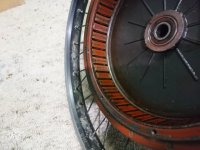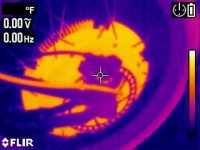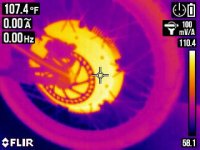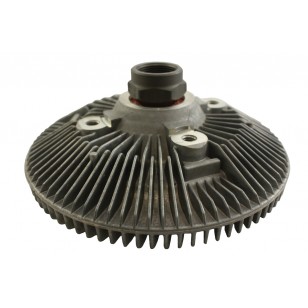From "bullfrog" posted with his permission:
Just a little data on my latest experiment...I tried to cool a MAC using a mixture of distilled water and Motul brand MoCool. The MoCool is a corrosion inhibitor and used in mainly motorcycle cooling systems to help prevent corrosion when ethylene glycol is not allowed...i.e. when race tracks will not allow the ethylene glycol to be used because it is slippery and a spill on the track would be extremely dangerous as well as take a long time to clean up.
Total volume of fluid used in my MAC was about five ounces...just enough to thermally connect the motor to the housing.
Well after running it for about four months, I thought my clutch was acting up...it was not freewheeling and would go back and forth between normal operation and not freewheeling. Disassembled the motor yesterday and it turns out the failure mode was the bearings in the planet gears. The gears themselves were fine. Just FYI, the planet gears and their bearings are the highest stressed portion of a planetary gear train...learned that a long time ago while doing accident investigations on helicopters.
As far as better...the water/MoCool had about the same core temps as the ATF so from a cooling perspective they work about the same.
The ATF lubricates the planetary gears and doesn't affect the the planet gear bearings BUT it can be extremely dangerous if you get a tiny amount on your brake rotor. I was riding along after running the ATF for a few months and all of a sudden I had no rear brakes.
The water/MoCool does not cause a problem if it gets on your rotor but it washes the lubricant out of the planet gear bearings so they eventually fail.
Turns out the bearings in the planet gears are "608" bearings and the same ones used in skateboard wheels. I have been researching options this morning for ceramic bearings produced for skateboard use in an attempt to find some good ceramic bearings at a reasonable cost.
As far as the water mixture affecting other parts of the motor, the only thing I noticed was that the copper windings had a dull appearance compared to when they were new and shiny. I never had any problems with any part of the motor, hall sensors, temp sensor, or anything not working due to corrosion or issues from the water mixture. I must qualify that with I only ran it for approximately four months so I can't really comment on the "long term" effects.
I did absolutely nothing to prepare the motor before using the water mixture...Justin at Grin Tech suggested coating the electronics to prevent problems but all I did was orient the axle so that the Hall sensors were at the highest elevation possible so that when I used about five ounces of cooling fluid, they did not sit in the fluid when the bike was stationary.
IMO the best thing to do for most people is to run either a 10T or a 12T MAC depending on how much you weigh and how many hills you have as well as use a wheel/tire no larger in diameter than a 26" Maxxis Hookworm and don't more than a 14s battery. That way overheating is never an issue.
I really wanted to try my 12T MAC with a 72v battery but it will definitely require some auxiliary cooling. I know the best bet for hot rodding like I am doing is a DD motor but I really like the small size and lightweight of the MAC.
Thanks for the recommendation on the ceramic bearings.











